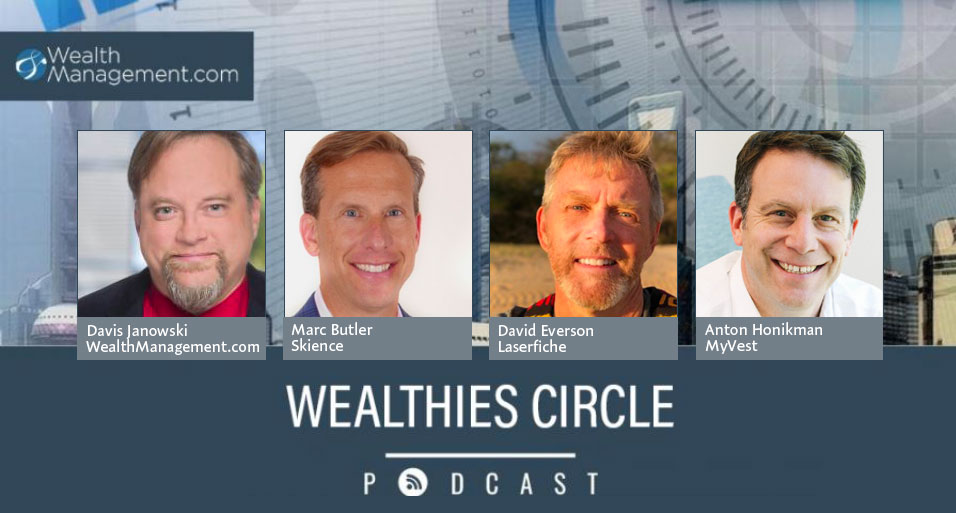MyVest’s CEO Anton Honikman joined David Everson from Laserfiche, Marc Butler from Skience, and Davis Janowski, senior technology editor at WealthManagement.com in a Wealthies Circle panel discussion covering innovations in wealthtech in the area of workflow automation to connect front, middle and back office operations. Highlights from the discussion follow.
The consensus of the group is that more efficient advisors equal more efficient firms. “Advisors don’t want to deal with technology. They want to turn it on and have it all work for them,” said Marc Butler of Skience, a wealth management platform that streamlines and automates business processes within the Salesforce environment.
Anton Honikman of MyVest went further, “It’s critical that when we talk about workflow automation, we are not here to only make advisors more efficient, we are here to make firms more efficient.” MyVest is a unified wealth management platform that integrates front office managed account workflows with the middle and back office to deliver personalized portfolios at scale.
As expectations of clients continue to rise, firms and their advisors need to provide effective solutions to removing friction and digitizing processes. “Firms are looking for ways of doing business that make it easy for everyone. It’s more and more a requirement that clients demand,” adds David Everson of Laserfiche, a leading provider of intelligent content management and business process automation.
Data Management & Integrations Are Key in the Middle and Back-office
The amount of data collected by a wealth management firm can be staggering. Managing all this data is essential to create a solid foundation for future growth. For example, it’s critical to have an investment book of record that is accurate and updated at least daily. When an account is traded, or a bill is generated or a performance report is generated, it needs to be done on accurate data. “The challenge of course is doing that at scale, it’s hard to do without significant investment in automation,” said Anton.
Tighter custodial integrations are key to back office operational efficiency. “Custodians are improving their APIs so that the integrations with the platforms that consume the data can be more automated and efficient,” said Anton. “There are many examples where these efficiencies can be realized, from new account opening, to funding, money movement, and new security set up. The nature of how you do the integrations can inform the downstream efficiencies and is an area that we are paying particular attention to.”
How Will Small Firms Survive?
“I fear that there will be a data divide between small solo practitioners and mid-size firms. Do you think there is a great divide between smaller advisors, the ones that desperately need to grow and larger firms that can take advantage and leverage these tools?” asked Davis Janowski of WealthManagement.com.
On a macro level, scale matters and will increasingly matter. Fee pressure and margin compression in any industry drives consolidation and scale. “There is a long-tail of small businesses that will struggle to have technology budgets and access to some of the tools that we are talking about,” said Anton. “Mitigating that is that many of them sit on some form of platform be it a custodian or a TAMP. Those platforms are increasingly adding technology capabilities to their service offerings. That way small firms themselves are not required to have a large technology staff because they are effectively outsourcing those capabilities to the platforms on which they sit.”
“As with any technology, people will drive adoption. Do you have people who really understand how to put the data to use?” asked Marc. “Part of it is a story about the divide and part is a story about the inevitability that you will need fewer people than before to handle the same amount of volume with more accuracy, more timeliness, and greater reliability,” said Anton.
“However, there is still a role for operations staff and data scientists. That role is shifting from being a traditional commodity function, to being something that is much more of a value-add function. How do you interpret the data? If you automated away the 90%, how do you diagnose the 10%? The focus is on more specialized, higher value human tasks, with more commodity tasks being done better by the digital technology tools we are talking about.”
“Advisors will have to take three steps back and invest time to get it set up right, but they will never look back once they get it into place,” concludes Marc.


![MyVest CEO predicts growth in model-delivery direct indexing [FundFire]](https://myvest.com/wp-content/uploads/Fundfire-1.png)
![MyVest CEO talks UMA upgrades and industry trends [FundFire]](https://myvest.com/wp-content/uploads/Fundfire.png)

![How to unlock tax savings in incoming client portfolios [Financial Planning]](https://myvest.com/wp-content/uploads/Anton-FP-.png)
![The Holistic Impact of Wealth and Retirement Plan Advisory M&A [PlanAdvisor]](https://myvest.com/wp-content/uploads/Screenshot-2024-08-13-at-9.50.52 AM.png)